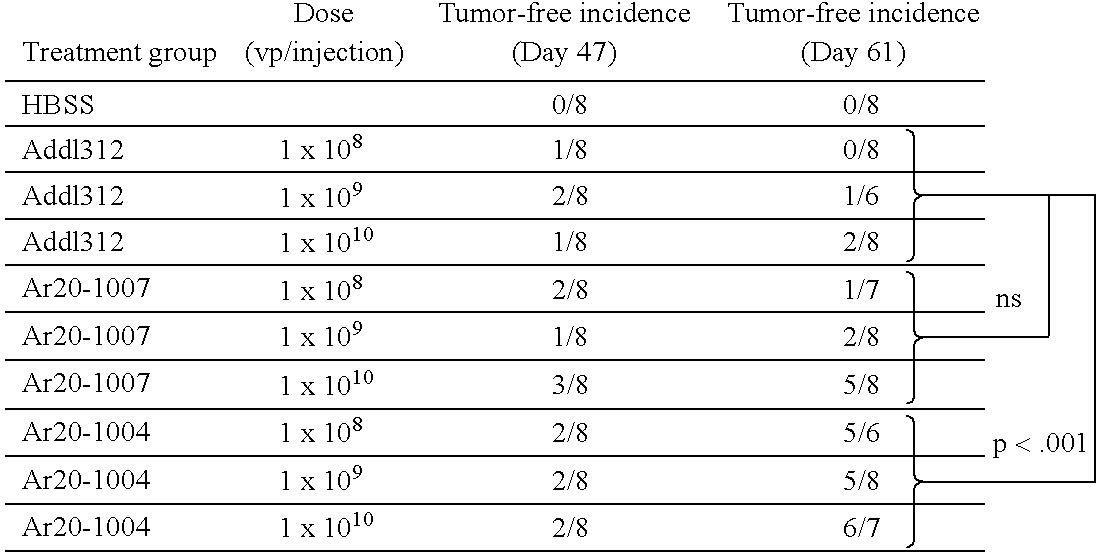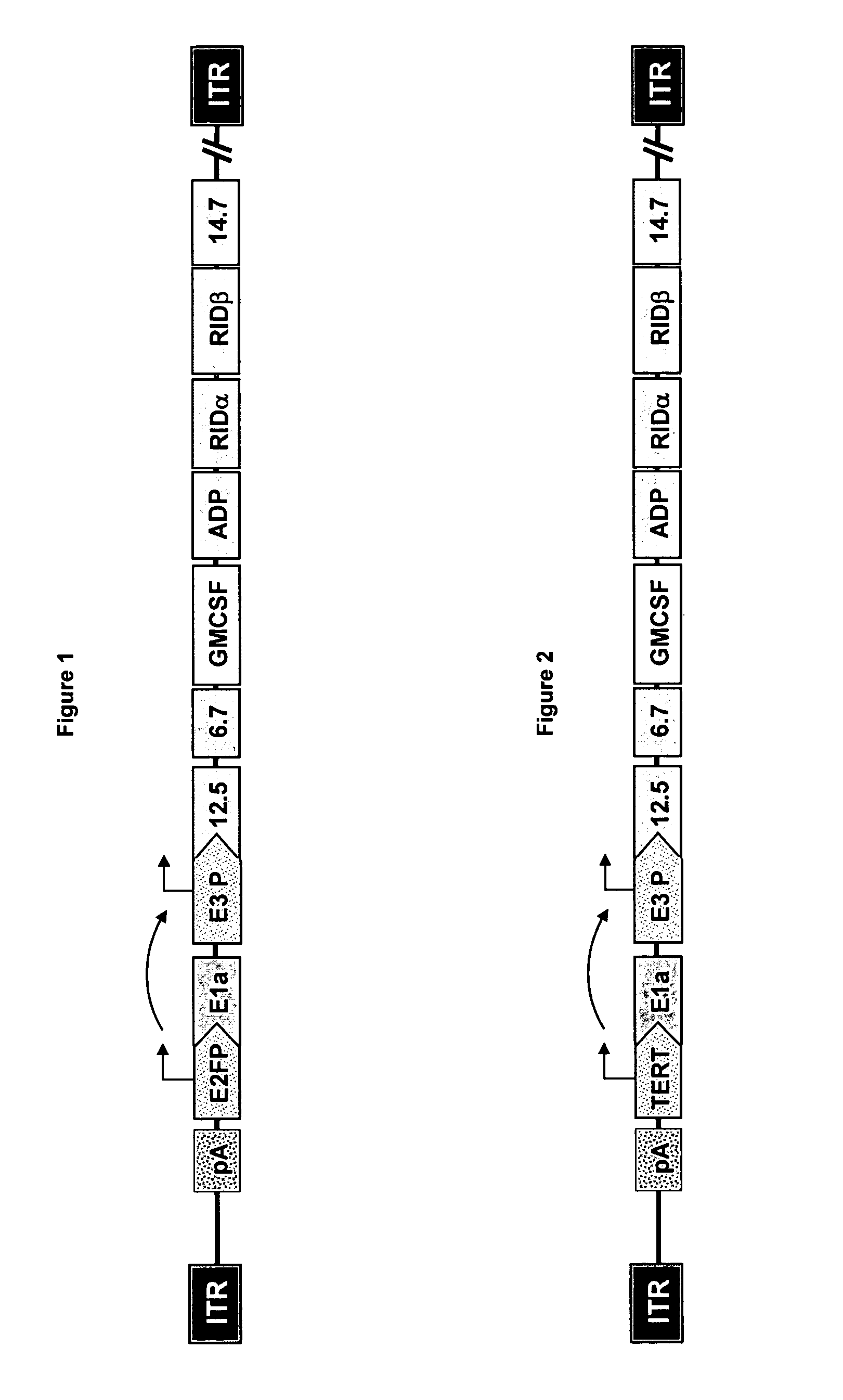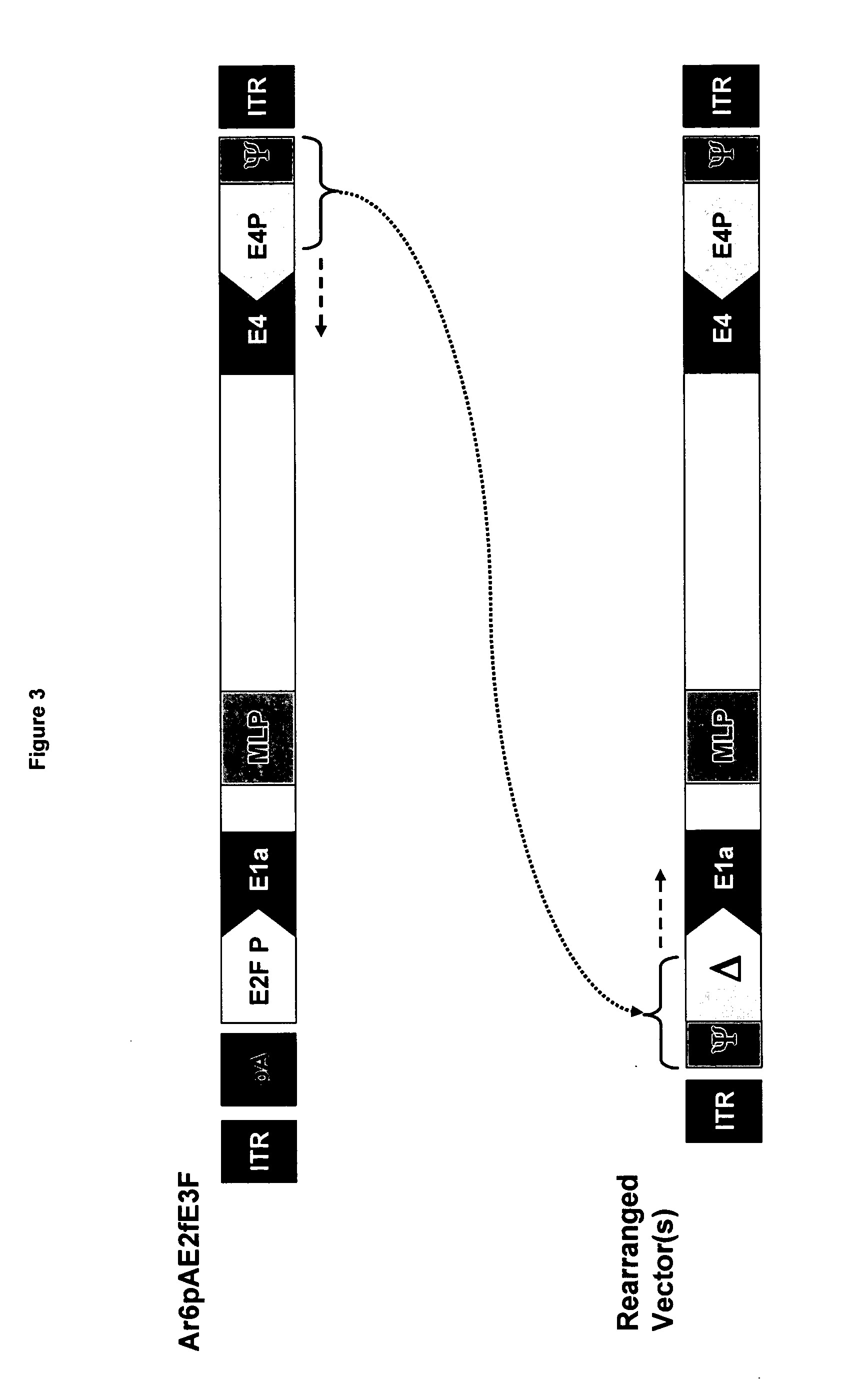Oncolytic adenoviral vectors encoding GM-CSF
a technology of adenoviral vectors and vectors, applied in the field of neoplastic disease treatment, can solve problems such as cell lysis
- Summary
- Abstract
- Description
- Claims
- Application Information
AI Technical Summary
Benefits of technology
Method used
Image
Examples
example 1
Construction of Ar20-1007 and Ar20-1004
[0126] Plasmid pDR1F was derived from the ligation of StuI / Mfel fragments of pDr1FRgd (9731 bp) and pDr2F (867 bp). Plasmid pDr1FRgd was the product of the ligation of a 10132bp AvrII, ClaI fragment of p5FlxHRFRGDL (Hay et al., J Vasc Res 38:315-323 2001) with a 495 bp / AvrII, ClaI fragment of a 595 bp PCR product of p5FlxHRFRGDL that introduced a SwaI site to the vector. Plasmid pDRIF was used in the generation of adenoviral right end donor plasmids.
[0127] Adenovirus right donor plasmids were constructed for Ar20-1007 (carrying human GM-CSF cDNA) and Ar20-1004 (carrying mouse GM-CSF cDNA) viral vectors. Donor plasmid pDr20hGmF carrying the human GM-CSF cDNA with the left end and the E2F-1 promoter was generated from recombination between plasmids pDRIF and pAr15pAE2fbGmF (described in WO 02 / 067861). Similarly, plasmid pDr20mGmF carrying the mouse GM-CSF cDNA was generated from recombination between pDR1F and pAr15pAE2fmGmF (also described in ...
example 2
Construction of Ar20-1006 and Ar20-1010
Large plasmids pAr20pATrtexhGmF and pAr20pATrtexmGmF were generated as follows:
[0139] The pDL5pATrtexF plasmid was digested with restriction enzymes AseI and BlpI, and electrophoresed in a 0.8% agarose gel to confirm the expected 9316 bp and 2140 bp DNA fragments. The digested DNA was cleaned with chloroform / phenol solution. The plasmids pAr20pAE2fhGmF and pAr20pAE2fmGmF were digested with restriction enzymes BstBI and BstZ171, and electrophoresed in a 0.8% agarose gel to confirm the expected DNA fragments. One hundred ng of AseI / BlpI digested pDL5pATrtexF (9316 bp fragment) and 100 ng of BstBI / BstZ171 digested pAr20pAE2fhGmF (32249 bp fragment) or pAr20pAE2fmGmF (32276 bp fragment) were co-transformed into BJ5186 cells. DNA minipreps from several colonies were digested with AscI. The colonies that matched the predicted RE pattern were transformed into DH5_cells to be amplified. The final plasmids pAr20pATrtexhGmF and pAr20pATrtexmGmF were c...
example 3
Confirmation of E2F Disregulation as Target of Ar20-1007
[0143] GM-CSF was cloned into a position under the control of the adenoviral E3 promoter. The E3 promoter is, in turn, transactivated by EIA (Horwitz M S. Adenoviruses. In: “Fields Virology, third edition,” ed Fields B N, Knipe D M, Howley P M, et al., Lippincott-Raven Publishers, Philadelphia, 1996, pp 2149-2171). Thus, ultimate control of the E3 promoter should be the result of the specificity of the E2F-1 promoter regulating the expression of the E1a gene. The Wi38-VA13 (VA13) cell line is an SV40 large T antigen (T-Ag) transformed derivative of Wi38 normal human diploid fibroblast cells. The T-Ag binds the Rb / E2F complex, resulting in the release of the E2F-1 transcription factor that is capable of activating its own promoter. As a result, VA 13 cells have higher levels of E2F-1 mRNA. The location of the packaging signal may impact on the selectivity of the promoter. Thus, this same cell pair was used as a model system to ...
PUM
| Property | Measurement | Unit |
|---|---|---|
| pH | aaaaa | aaaaa |
| volume | aaaaa | aaaaa |
| volume | aaaaa | aaaaa |
Abstract
Description
Claims
Application Information
 Login to View More
Login to View More - R&D
- Intellectual Property
- Life Sciences
- Materials
- Tech Scout
- Unparalleled Data Quality
- Higher Quality Content
- 60% Fewer Hallucinations
Browse by: Latest US Patents, China's latest patents, Technical Efficacy Thesaurus, Application Domain, Technology Topic, Popular Technical Reports.
© 2025 PatSnap. All rights reserved.Legal|Privacy policy|Modern Slavery Act Transparency Statement|Sitemap|About US| Contact US: help@patsnap.com



